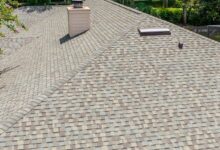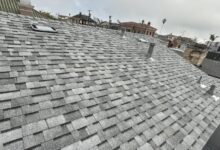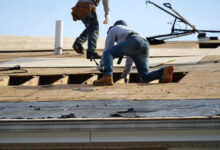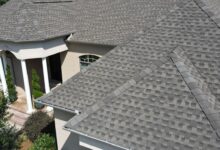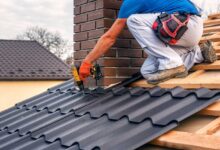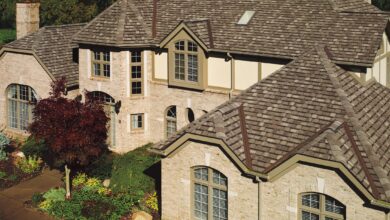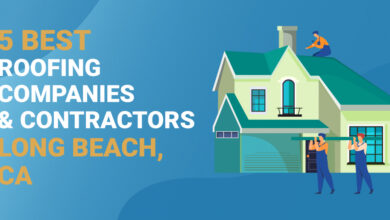Englewood Roofers: A Comprehensive Guide
Englewood Roofers represent a significant sector of the local economy, providing crucial services for homeowners and businesses alike. This guide delves into the multifaceted world of Englewood roofing, exploring the competitive landscape, diverse service offerings, and the critical role of customer satisfaction. We’ll examine the various roofing materials used, installation processes, common repair needs, and the importance of preventative maintenance in Englewood’s specific climate. Furthermore, we will discuss the business operations, licensing requirements, and marketing strategies employed by successful Englewood roofing companies.
From understanding the nuances of asphalt shingle roofs to navigating the complexities of project management and customer relations, this comprehensive overview aims to provide valuable insights for both consumers seeking roofing services and professionals operating within the industry. We will cover everything from choosing the right roofing material to understanding the costs involved and ensuring a positive customer experience throughout the entire process.
Englewood Roofers
Englewood, Colorado, boasts a vibrant and competitive roofing market, catering to a diverse range of residential and commercial properties. Understanding the landscape of roofing services in Englewood is crucial for both homeowners seeking repairs or replacements and businesses looking for reliable contractors.
Englewood Roofing Market Competitive Landscape
The Englewood roofing market is characterized by a mix of large, established companies and smaller, locally-owned businesses. Competition is fierce, with companies vying for market share through pricing, service offerings, and marketing strategies. Larger firms often leverage economies of scale to offer competitive pricing, while smaller companies may focus on personalized service and quicker response times. The market also includes specialized roofing contractors focusing on particular materials or roofing types (e.g., tile, metal, flat roofing). This competitive environment benefits consumers by providing a variety of choices and price points.
Primary Services Offered by Englewood Roofers
Englewood roofing companies offer a comprehensive range of services to meet diverse customer needs. These typically include roof inspections and repairs, roof replacements (for various roofing materials like asphalt shingles, tile, metal, and flat roofing), gutter installation and repair, and emergency roof leak services. Some companies also offer additional services such as skylight installation, attic ventilation improvements, and snow removal from roofs. The availability of these supplementary services varies depending on the individual contractor.
Pricing Strategies of Englewood Roofing Businesses
Pricing strategies among Englewood roofing businesses vary significantly. Some companies use a fixed-price model, providing a quote based on the scope of work. Others employ a time-and-materials approach, charging based on the labor hours and materials used. Discounts are often offered for larger projects or repeat customers. It’s crucial for consumers to obtain multiple quotes from different companies to compare pricing and services before making a decision. Factors influencing pricing include the size and complexity of the project, the type of roofing material, and the contractor’s overhead costs. Transparent and detailed quotes should be requested to avoid unexpected costs.
Typical Customer Demographics for Englewood Roofing Services
The customer demographic for Englewood roofing services is broad, encompassing homeowners of various ages and income levels, as well as commercial property owners and property management companies. The need for roofing services arises from factors like age and condition of the roof, weather damage (hail, snow, wind), and general wear and tear. Homeowners in older neighborhoods might require more frequent repairs or replacements compared to newer developments. Commercial clients often require specialized roofing solutions and larger-scale projects.
Comparison of Englewood Roofing Companies
The following table compares four hypothetical Englewood roofing companies. Note that this is for illustrative purposes and actual company data may vary. Always conduct your own research before selecting a contractor.
| Company Name | Specialization | Contact Information | Customer Reviews (Example) |
|---|---|---|---|
| Apex Roofing Solutions | Asphalt shingle repair and replacement | (303) 555-1212, [email protected] | “Fast, efficient, and professional service. Highly recommend!” |
| Peak Roofing & Construction | Tile roofing, new construction | (720) 555-3434, [email protected] | “Excellent quality workmanship and attention to detail.” |
| Summit Roofing Co. | Flat roofing, emergency repairs | (303) 555-4545, [email protected] | “Responded quickly to our emergency leak. Very reliable.” |
| Highpoint Roofing Specialists | Metal roofing, commercial projects | (720) 555-6767, [email protected] | “Professional and knowledgeable team. Great for commercial work.” |
Englewood Roofers
Englewood Roofers offers a comprehensive range of roofing services designed to meet the specific needs of homeowners in the Englewood area. We understand the unique challenges posed by the local climate and utilize high-quality materials and expert installation techniques to ensure long-lasting, durable roofs.
Roofing Materials Used in Englewood
Englewood homes utilize a variety of roofing materials, each with its own advantages and disadvantages. Asphalt shingles remain the most common choice due to their affordability and ease of installation. Tile roofs, particularly clay and concrete, are increasingly popular for their durability and aesthetic appeal, offering excellent protection against the harsh Colorado sun. Metal roofing, including steel and aluminum, provides exceptional longevity and resistance to extreme weather conditions, making it a worthwhile investment for long-term protection.
Roofing Installation Processes
The installation process varies depending on the chosen material. Asphalt shingle installation involves careful layering and sealing of individual shingles to create a waterproof barrier. Tile roof installation is more labor-intensive, requiring precise placement and secure fastening of each tile. Metal roofing installation often involves specialized tools and techniques to ensure proper seams and watertight seals. Each process demands skilled labor and adherence to strict building codes.
Common Roofing Repairs in Englewood’s Climate
Englewood’s climate, characterized by intense sun, hailstorms, and occasional heavy snow, necessitates frequent roof repairs. Common issues include shingle damage from hail, leaks around flashing (where different roof sections meet), and gutter clogging from debris. Water damage from ice dams (ice build-up at the roof’s edge) is also a significant concern during winter. Regular inspections can help identify and address these problems before they escalate.
Roof Maintenance and Preventative Measures
Regular roof maintenance is crucial for extending the lifespan of your roof and preventing costly repairs. This includes annual inspections to check for damage, cleaning gutters and downspouts to ensure proper drainage, and promptly addressing any leaks or damage. Preventative measures, such as trimming overhanging branches to reduce debris accumulation and installing ice and water shields under shingles, can significantly reduce the risk of future problems.
Typical Roof Repair Project Flowchart
The following flowchart illustrates the steps involved in a typical roof repair project:
[Imagine a flowchart here. The flowchart would begin with “Problem Identified,” leading to “Inspection and Assessment,” then to “Materials Ordered,” followed by “Repair Work,” “Quality Check,” and finally, “Project Completion.” Each step would have a brief description clarifying the activities involved. For example, “Inspection and Assessment” might include a visual inspection, identifying the extent of damage, and creating a detailed estimate. “Materials Ordered” would involve selecting appropriate materials based on the assessment and ordering them from a supplier. “Repair Work” would encompass the actual repair process, involving careful removal of damaged materials and installation of new ones. “Quality Check” would be a thorough inspection to ensure the repair was done correctly and effectively. Finally, “Project Completion” would involve cleaning up the work area and providing the client with a completion report.]
Englewood Roofers
Englewood Roofers is committed to providing exceptional roofing services, and a crucial element of this commitment is ensuring a positive customer experience. We understand that a roofing project can be stressful, so we strive to make the process as smooth and transparent as possible. This involves proactive communication, managing expectations effectively, and resolving any issues promptly and fairly.
Customer Communication and Satisfaction Strategies
Improving customer communication and satisfaction requires a multi-faceted approach. This includes readily available communication channels, such as phone, email, and text messaging, allowing customers to easily contact us with questions or concerns. We also provide regular project updates, keeping customers informed of progress and any potential delays. Furthermore, we actively solicit feedback through surveys and reviews, using this information to identify areas for improvement and enhance our services. Proactive communication, such as sending welcome packets with project timelines and contact information, sets a positive tone from the outset. Post-project follow-ups also demonstrate our ongoing commitment to customer satisfaction.
Challenges in Managing Customer Expectations
Managing customer expectations during roofing projects presents several potential challenges. Unforeseen issues, such as discovering underlying damage during the project, can lead to delays and increased costs. Weather conditions can also significantly impact project timelines. Open and honest communication is key to mitigating these challenges. Clearly outlining potential issues and contingencies upfront, including the possibility of unexpected costs or delays, helps set realistic expectations. Providing detailed contracts with clear payment schedules and project timelines further minimizes misunderstandings. For example, explicitly stating that unforeseen structural issues discovered during tear-off might necessitate additional costs and adjustments to the timeline can prevent future disputes.
Best Practices for Handling Customer Complaints and Resolving Disputes
Handling customer complaints and resolving disputes effectively requires a proactive and empathetic approach. We prioritize prompt acknowledgment of complaints, followed by a thorough investigation to understand the issue. We aim to resolve issues fairly and efficiently, offering solutions that address the customer’s concerns. In cases of significant disputes, we may consider mediation or arbitration to ensure a fair and impartial resolution. Maintaining a detailed record of all communications and actions taken is crucial for transparency and accountability. For example, documenting all communication attempts, proposed solutions, and the customer’s responses creates a clear record should further escalation be necessary.
Common Customer Questions and Answers
It’s important to anticipate common customer questions to proactively address concerns and build trust.
- Q: What is your warranty? A: We offer a comprehensive warranty covering materials and workmanship for [Number] years. Details are outlined in your contract.
- Q: How long will the project take? A: The project timeline depends on the size and complexity of the roof, as well as weather conditions. We will provide a detailed estimate upon inspection.
- Q: What payment methods do you accept? A: We accept [List accepted payment methods].
- Q: What if I have unexpected damage discovered during the project? A: We will contact you immediately to discuss the issue, provide a detailed explanation of the damage, and present options for repair. Additional costs will be clearly outlined and agreed upon before proceeding.
- Q: What permits are required? A: We handle all necessary permits and inspections. You will be kept informed of their status.
Sample Email Template for Communicating Project Updates
Subject: Englewood Roofers Project Update – [Client Name] – [Project Address]
Dear [Client Name],
This email provides an update on the progress of your roofing project at [Project Address]. [Insert brief description of progress, e.g., “The tear-off is complete and we are now beginning the installation of the underlayment.”].
[Insert any relevant information, e.g., “We encountered a minor delay due to [reason for delay], but we anticipate completing the project by [new completion date].”].
[Insert any next steps, e.g., “We will be contacting you to schedule a final inspection once the project is complete.”].
Please do not hesitate to contact us if you have any questions or concerns.
Sincerely,
The Englewood Roofers Team
Englewood Roofers
Englewood Roofers requires a robust understanding of business operations to ensure success and client satisfaction. This includes navigating legal requirements, managing risk, implementing effective marketing strategies, and efficiently handling project logistics. Understanding these operational aspects is crucial for building a reputable and profitable roofing business.
Licenses and Permits for Roofing Businesses in Englewood
Operating a roofing business in Englewood necessitates obtaining the necessary licenses and permits. This typically involves contacting the City of Englewood’s licensing department to determine the specific requirements, which may include a business license, a contractor’s license, and potentially permits for specific projects depending on their scope and location. Failure to obtain these permits can result in significant fines and legal repercussions. It is recommended to consult with a legal professional specializing in business licensing to ensure full compliance.
Insurance and Liability Coverage for Roofing Contractors
Comprehensive insurance and liability coverage are paramount for protecting both the business and its clients. General liability insurance protects against claims of property damage or bodily injury, while workers’ compensation insurance covers medical expenses and lost wages for employees injured on the job. Commercial auto insurance is also crucial if company vehicles are used for business purposes. Adequate insurance coverage minimizes financial risk and builds client trust by demonstrating a commitment to safety and responsibility. The level of coverage should be commensurate with the scale of the business and the types of projects undertaken.
Marketing Strategies for Reaching Potential Customers
Effective marketing is vital for attracting new clients. Englewood Roofers can utilize a multi-pronged approach, including online marketing (website, SEO, social media advertising), local advertising (newspaper ads, flyers, community events), and referrals from satisfied clients. Building a strong online presence through a professional website and active social media engagement is crucial in today’s digital landscape. Targeted advertising campaigns, focusing on specific demographics and geographic areas, can maximize marketing ROI. Furthermore, consistently delivering high-quality workmanship and excellent customer service fosters positive word-of-mouth referrals, a powerful marketing tool.
Managing Roofing Project Timelines and Budgets
Efficient project management is key to profitability and client satisfaction. Utilizing project management software can help track timelines, budgets, and resources. Different project management methodologies, such as Agile or Waterfall, can be adapted to suit the specific needs of each project. Creating detailed project plans, including material lists, labor estimations, and scheduling milestones, is essential. Regular communication with clients regarding project progress and any potential delays is crucial for maintaining transparency and trust. For example, using a Gantt chart can visually represent task dependencies and deadlines, allowing for proactive adjustments if delays occur. Budget management involves accurate cost estimations, tracking expenses, and monitoring potential cost overruns.
Calculating Material Costs and Labor Expenses for Roofing Projects
Accurate cost estimation is crucial for profitable project bidding. Material costs are determined by calculating the quantity of materials needed based on the roof’s dimensions and the type of roofing materials being used. Labor expenses involve estimating the number of workers, their hourly rates, and the total hours required for each project phase. For example, a simple asphalt shingle roof might require less labor than a complex tile roof installation. A detailed breakdown of all costs, including materials, labor, permits, and equipment rental, should be included in project bids. Consider incorporating a contingency buffer to account for unforeseen expenses or delays. A formula for basic cost calculation could be:
Total Project Cost = (Material Cost per unit * Quantity of Units) + (Labor Rate per hour * Total Labor Hours) + Overhead Costs + Profit Margin
Englewood Roofers
Englewood Roofers provides comprehensive roofing services, ensuring the longevity and protection of your home. We understand the importance of a well-maintained roof and offer expertise in installation, repair, and maintenance for a variety of roofing materials. Our commitment to quality and customer satisfaction is paramount.
Asphalt Shingle Roof Appearance
A properly installed asphalt shingle roof presents a uniform, smooth surface with neatly aligned shingles. Individual shingles, typically rectangular, overlap in a staggered pattern, creating multiple layers for enhanced weather protection. The edges of the shingles should be straight and even, with minimal gaps visible between them. Flashing, a thin metal sheet, is visible around chimneys, vents, and valleys, providing a watertight seal at these critical points. The ridge cap, a specialized type of shingle, covers the peak of the roof, providing a clean, finished look. Properly installed underlayment, a waterproof membrane beneath the shingles, is not directly visible but contributes to the roof’s overall integrity.
Damaged Roof Appearance
A damaged roof shows various signs of deterioration. Missing or damaged shingles are obvious indicators, often leaving exposed areas of underlayment or sheathing. Curling or buckling shingles suggest age or moisture damage. Dark streaks or stains on the roof surface often indicate water damage or algae growth. Sagging or uneven areas suggest structural problems or compromised roofing materials. The flashing around chimneys or vents may show signs of rust or deterioration, indicating potential leaks. Granules from the shingles may be accumulating in gutters, indicating shingle degradation. Significant cracking in the roof surface could also be a sign of severe damage.
Visual Differences Between Roofing Materials
Asphalt shingles, the most common type, appear as a relatively flat, textured surface in a variety of colors. Clay or concrete tiles exhibit a more three-dimensional appearance, with individual tiles clearly defined and often featuring textured surfaces. Metal roofing, typically made of aluminum or steel, has a smooth, metallic sheen and often comes in panels or sheets with visible seams. The visual weight and texture of each material differ significantly. Tile roofs often have a heavier, more substantial appearance than asphalt shingle roofs, while metal roofs present a more modern and sleek aesthetic.
Roofing Crew at Work
A typical roofing crew comprises several workers, each with specific tasks and safety gear. Workers wear hard hats to protect against falling objects, safety harnesses for working at heights, and cut-resistant gloves for handling sharp materials. They utilize ladders and scaffolding, ensuring secure footing and access to all areas of the roof. Safety ropes and fall arrest systems are often in place, especially when working on steep slopes. The crew employs various tools, including nail guns, hammers, and utility knives, all while adhering to strict safety protocols. Their movements are coordinated, reflecting a structured approach to roofing installation or repair.
Closing Summary
Ultimately, the success of any Englewood roofing business hinges on a combination of technical expertise, efficient operations, and a commitment to exceptional customer service. By understanding the market dynamics, mastering the technical aspects of roofing, and prioritizing client satisfaction, roofing companies in Englewood can thrive and contribute to the community’s well-being. This guide has aimed to provide a comprehensive overview of this vital sector, offering valuable information for both consumers and professionals navigating the world of Englewood roofing.

